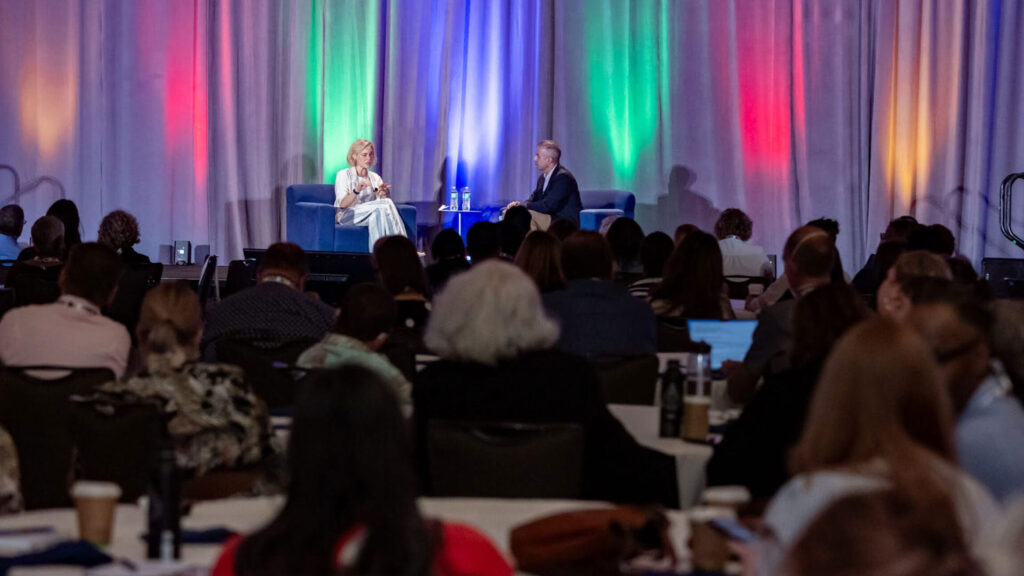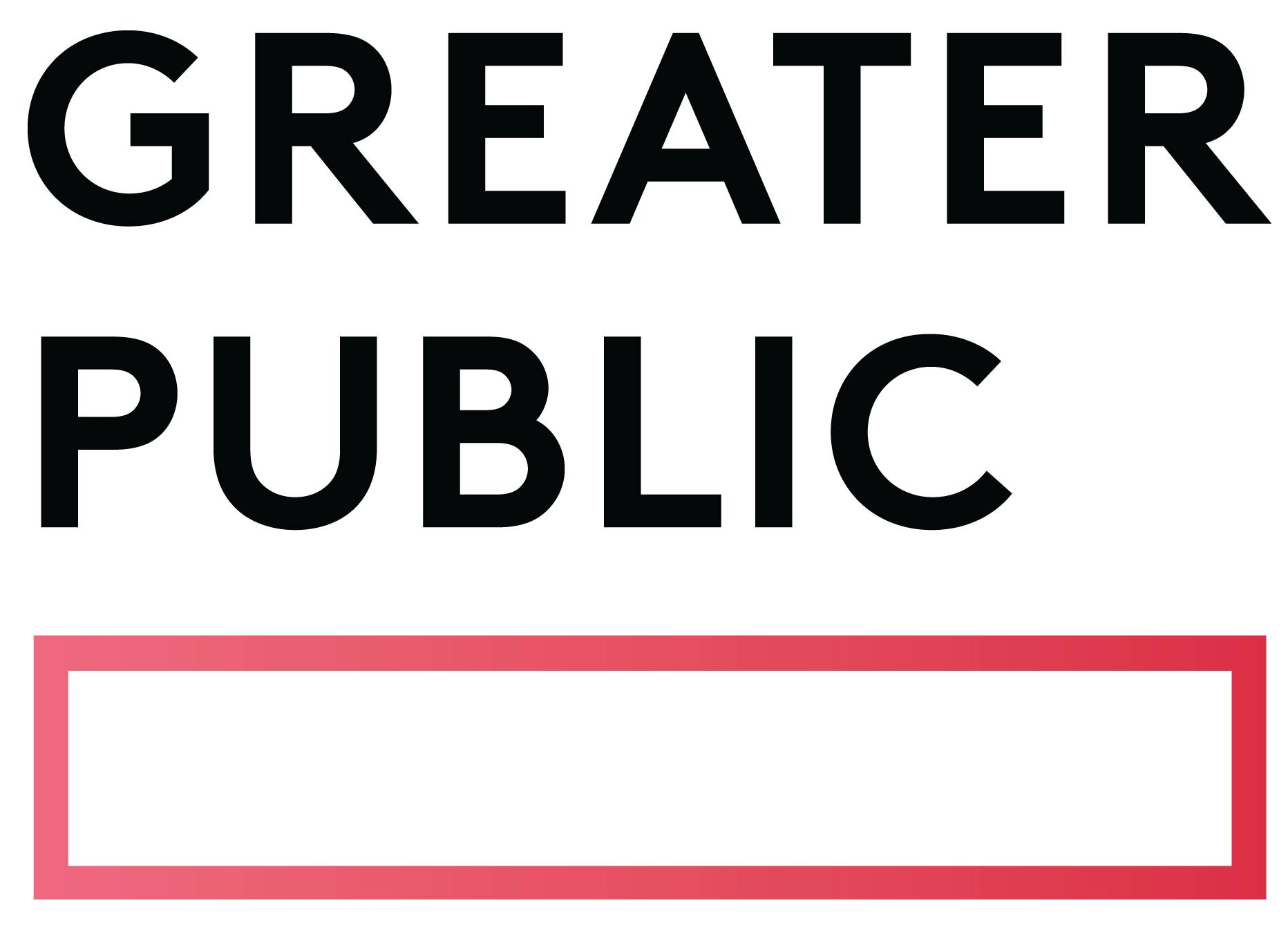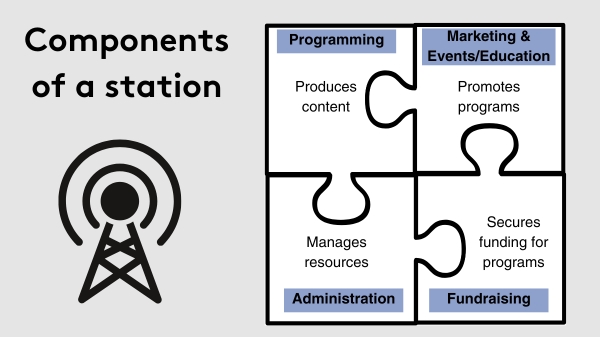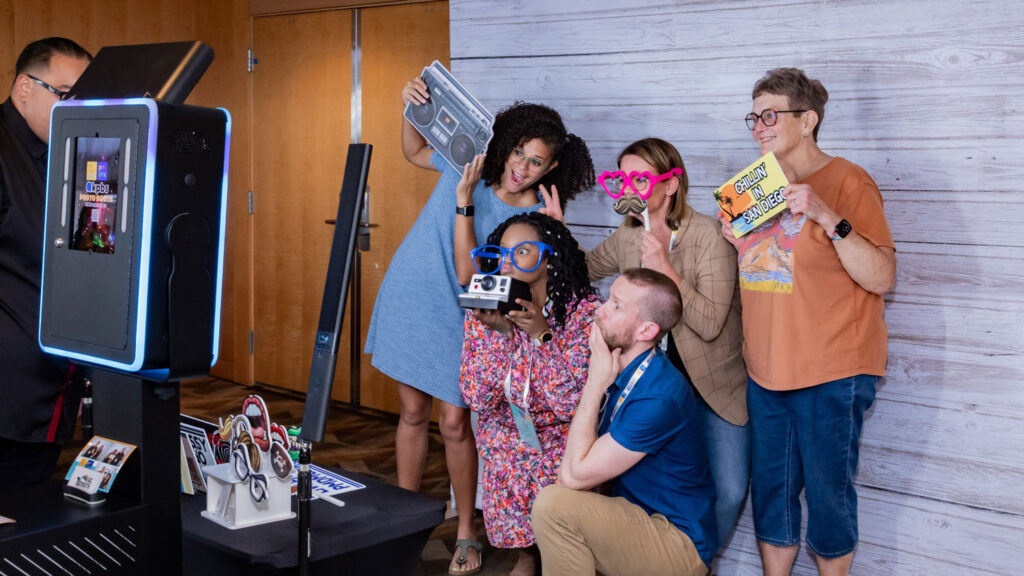Understand public media’s origins, component parts, and structure.
Navigate this page
Every industry has its own origin story, players, and jargon. We’ve curated lists of the important terms and organizations in public media to help anyone new to our industry get a firm foundation in essential industry knowledge. Please reach out directly to us at communications@greaterpublic.org if you feel something needs to be added to this public media guide.

Why does public media exist?
Non-Commercial Educational broadcast stations (NCEs) were formally established and supported by legislation during the presidency of Lyndon B. Johnson with the creation of the Public Broadcasting Act of 1967. This act laid the foundation for modern public broadcasting in the United States by creating the Corporation for Public Broadcasting (CPB), which helped fund and support non-commercial educational programming, leading to the development of public broadcasters like PBS (Public Broadcasting Service) and NPR (National Public Radio).
President Johnson and the bipartisan Congress that passed the legislation sought to create a broadcasting system that would enrich American society by providing educational and cultural programming to the public, free from commercial pressures. In his remarks when signing the Public Broadcasting Act into law, Johnson emphasized the importance of using media to serve the public good, stating that it could “enlarge the horizons of every American, enrich man’s spirit, and free his mind to explore the bold and unknown.”
While the concept of non-commercial educational broadcasting existed earlier (with some educational stations operating since the 1920s), Johnson’s leadership and the Public Broadcasting Act of 1967 significantly expanded the scope and reach of Non-Commercial Educational broadcasters (NCEs), formalizing their role in American media.
What role does the FCC play in public broadcasting?
The Federal Communications Commission (FCC), established in 1934, plays several crucial roles in the regulation, licensing, and oversight of Non-Commercial Educational (NCE) stations to ensure they fulfill their educational mission and operate within the legal framework designed for public broadcasting. Here’s an overview of the FCC’s role in NCEs:
- Licensing and Frequency Allocation: The FCC issues and assigns broadcast frequencies specifically reserved for NCE stations, typically located in the lower end of the FM radio band (88.1 to 91.9 MHz) and are reserved for non-commercial use to prevent competition with commercial broadcasters.
- Regulating Non-Commercial Status: The FCC ensures that NCE stations do not air traditional commercials or profit-driven advertising. Instead, NCEs can broadcast underwriting announcements from sponsors, but these must be factual and free of calls to action, qualitative statements, or price information.
- Ensuring Educational Purpose and Public Service: The FCC requires stations to demonstrate a commitment to public service, local community needs and providing educational, cultural, and informational content, which may include news, arts, music, or community programming. The FCC reviews the content and operations of NCE stations during license renewals to ensure they continue to meet these educational standards.
- Enforcing Equal Opportunity and Accessibility Rules: The FCC enforces rules ensuring that NCE stations provide equal access to political candidates if they choose to air political content, though NCEs are exempt from some commercial requirements like the “equal time” rule for candidates if they focus on genuine news coverage. NCEs are also subject to rules on making content accessible to individuals with disabilities, including the use of closed captioning for TV and video programming.
- Handling Complaints and Compliance: The FCC handles complaints and enforces compliance with regulations related to content, advertising, licensing, and public service obligations for broadcast. If an NCE station is found in violation of these rules, the FCC can take actions such as issuing fines or revoking licenses.

Who are the major national organizations in public media?
Financial supporters
- Corporation for Public Broadcasting (CPB)
The CPB is a private, nonprofit corporation funded by federal dollars. It provides essential funding and grants to support public radio and television stations nationwide, particularly in underserved areas. Over 70% of CPB’s funding is distributed to more than 1,500 locally owned public radio and television stations. The CPB also supports public broadcasting infrastructure and programming, and it allocates funds to national content providers like PBS and NPR. - National Endowment for the Arts (NEA)
The NEA offers grant funding to U.S. nonprofit arts organizations, colleges and universities, federally recognized tribal communities, individual writers and translators, and public broadcasting providers. NEA funding supports arts programming on public television and radio. Through its media arts grants, it helps fund cultural and educational projects, including documentaries, public radio series, and other media initiatives that highlight the arts. - National Endowment for the Humanities (NEH)
The NEH offers grant funding to U.S. humanities programs including museums, archives, libraries, colleges, universities, individual scholars, and public broadcasters. NEH funding supports content related to history, culture, and the humanities. Many historical documentaries and educational series aired on PBS have received NEH funding. - U.S. Department of Education (DOE)
The DOE, with funding from Congress (i.e. the Ready To Learn Television Act), has funded television programming and corresponding educational materials for preschool and elementary school children since the early 1990s, as a way to improve school readiness. This includes many PBS KIDS programs, local PBS station initiatives, and corresponding early education research and resources. - American Journalism Project (AJP)
The AJP is a non-profit venture philanthropy organization that grants to nonprofit news organizations, partners with communities to launch new organizations, and coaches leaders as they grow and sustain their newsrooms. - John D. and Catherine T. MacArthur Foundation
This private, non-profit foundation provides grants to organizations in more than 100 countries that align with its mission, including public broadcasting projects such as documentaries and programs that tackle social justice, human rights, and critical global issues. It has provided significant grants for investigative journalism and educational media on platforms like PBS and NPR. - Ford Foundation
This private, non-profit foundation provides hundreds of grants each year to organizations that align with its mission of addressing inequality. The Ford Foundation has historically been a major funder of public media, supporting initiatives that promote social justice, public interest journalism, and educational content. Ford often funds projects that explore issues of inequality, democracy, and social innovation. - Carnegie Corporation of New York
This philanthropic foundation provides grants to organizations that align with its mission to support education, democracy, international peace and security, and higher education. The Carnegie Corporation played a key role in the early development of public broadcasting and continues to fund public broadcasting projects that aim to strengthen civic discourse and public media infrastructure. - Bill & Melinda Gates Foundation
This private, non-profit foundation offers grants to organizations that align with its mission to alleviate poverty, disease, and inequity around the world. The Gates Foundation has funded educational programming and media literacy efforts within public broadcasting. - Annenberg Foundation
This private, non-profit foundation is known for its commitment to educational media. The Annenberg Foundation has funded various public media initiatives, particularly those related to K-12 and lifelong learning. The foundation has supported educational programming, documentaries, and digital resources for public broadcasters. - Knight Foundation
This private, non-profit foundation provides grants to organizations that align with its mission of free expression and journalism, arts and culture in community, research in areas of media and democracy. The Knight Foundation has provided funding to many local news and digital innovation projects. - Wyncote Foundation
This private, non-profit foundation provides grants to organizations that align with its mission of supporting arts, culture, education, the environment, health, human services, and preservation. Wyncote provides significant support to public media, with a focus on media that promotes social impact, local journalism, and community engagement. It funds a variety of public media initiatives, especially those aimed at reaching diverse audiences and enhancing public media’s community service role.
Content providers
- Public Broadcasting Service (PBS)
PBS is a nonprofit membership-based organization distributing educational, science, history, public affairs, lifestyle, cultural, documentary, children’s content, and fundraising support to over 350 locally owned and operated member stations across the U.S. PBS also creates development, marketing, digital, and other assets to help member stations leverage national content locally, including streaming content via PBS Passport. PBS hosts the PBS Annual Meeting each year, where PBS staff, station representatives, and industry professionals gather to discuss key issues. PBS also regularly offers station-facing training and webinars. - National Public Radio (NPR)
NPR is a nonprofit membership-based organization providing news, cultural, and music programming to more than 1,000 public radio stations across the U.S. NPR produces a range of programs, including Morning Edition and All Things Considered, and distributes them to member stations, which are independent but adhere to NPR’s standards for content. - American Public Media (APM)
APM is one of the largest independent producers and distributors of public radio content in the U.S. It provides programming to affiliated stations across the country, with shows like Marketplace, The Splendid Table, and BBC World Service for radio distribution. - American Public Television (APT)
APT is a leading syndicator and distributor of programming to local PBS stations across the country, including the multicast channels Create and World. - PRX (Public Radio Exchange)
PRX is a nonprofit media organization that distributes content for public radio and podcasts and supports independent and local creators. Known for its innovative approach to public media, PRX is home to popular programs and podcasts such as The Moth Radio Hour and TED Radio Hour.
National associations and notable nonprofits
- Greater Public
Greater Public provides fundraising, marketing, and membership support for public media stations. It offers resources, webinars, and consulting on how to increase donations and sponsorship revenue for both public television and radio stations. Greater Public hosts the Public Media Development and Marketing Conference (PMDMC) each year, which is public media’s largest conference devoted to revenue generation, marketing, and management. - America’s Public Television Stations (APTS)
APTS is a nonprofit organization that advocates for public television stations in areas like federal funding, public policy, and spectrum issues. It represents local public TV stations across the country and works to protect and increase funding for public broadcasting. APTS hosts an annual summit, which is a gathering of public broadcasting general managers and community leaders who explore issues related to the future and mission of public service media. - Public Media Business Association (PMBA)
PMBA is a professional association focused on the financial, business, and administrative aspects of public media. It offers training, best practices, and networking opportunities for public media professionals working in finance, management, and operations. PMBA hosts an annual conference for general managers, HR, and finance professionals from public media. - Public Media Journalists Association (PMJA)
PMJA (formerly PRNDI) is dedicated to public media journalists, providing training, resources, and advocacy to support high-quality journalism within public broadcasting. PMJA also hosts an annual conference focused on the needs of public media reporters, editors, and news directors. - Public Media Content Collective (PMCC, fka PRPD)
PMCC (formerly Public Radio Program Directors) is an association that serves public radio programmers and producers, helping them improve the quality of programming and audience engagement. It offers resources, training, and professional development for public radio content creators. PMCC hosts an annual conference focusing on public media audience, content, and programming. - Radio Research Consortium (RRC)
The RRC is a non-profit research company that provides listener data on radio audiences to non-commercial stations in the United States. Data is obtained through a contract with Nielsen Audio. - Station Resource Group (SRG)
SRG is a nonprofit focused primarily on supporting senior leadership at its 50 member organizations across the country in developing strategy and ensuring operational excellence. SRG hosts an annual retreat for its members. - National Educational Telecommunications Association (NETA)
NETA provides support to public television stations, particularly in the areas of programming, education, community engagement, and professional development. It helps stations access high-quality content and offers training and resources for public media professionals. NETA hosts an annual conference for public media station staff, board members, and community engagement professionals. - National Federation of Community Broadcasters (NFCB)
NFCB is a non-profit organization that supports community radio stations across the United States. Founded in 1975, the NFCB represents a diverse group of community broadcasters, including many small, rural, and minority-serving stations, as well as stations that rely heavily on volunteer efforts. NFCB hosts an annual conference for participants to discuss and teach skills in community radio. - National Public Media (NPM)
Jointly owned by NPR, PBS, and GBH, NPM is a full-service sponsorship organization and exclusive sponsorship representative of the NPR Network. NPM also works occasionally on multi-market sponsorship campaigns with local public media stations across the country. - Association of Independents in Radio (AIR)
AIR is a network of independent audio producers and journalists that partners with public radio to develop and share innovative content. It provides professional support for freelancers and advocates for independent producers within the public media ecosystem. - Public Media Women in Leadership (PMWL)
PMWL is a nonprofit organization that connects women across public media, outlines pathways to career excellence, and recognizes the need and urgency to increase women in leadership positions. PMWL holds regular virtual meetings and the Brave Talk conference each year that coincides with Greater Public’s Public Media Development and Marketing Conference. - Public Media for All (PM4A)
PM4A is a coalition and advocacy initiative dedicated to increasing diversity, equity, inclusion, and accessibility (DEIA) within the public media sector. - Public Radio Association of Development Officers (PRADO)
The PRADO Slack is a service for public media development officers. It offers several different channels and gives users valuable information for their work and for their personal and professional development. - National Multicultural Alliance (NMCA)
The NMCA is a non-profit alliance of five distinct national organizations, which, with modest support from the CPB, bring the authentic stories and diverse perspectives of America’s multicultural communities to public media and its digital platforms. They include: - University Station Alliance (U:SA)
The U:SA is a non-profit organization that strengthens the public media system through improving the relationship between broadcasters and institutions.
Affinity groups
- Assorted Greater Public Affinity Groups exist to bring professionals together around similar needs or characteristics.
- YAYAHPs is Greater Public’s Young and Young-at-Heart Professionals group, serving people who have worked in public media for less than 5 years or who are under 35 years old.
- YoProWo is PBS’s young professionals group
- Neurodivergent Professionals in Public Media is an affinity space for public media professionals who are neurodivergent and/or have mental health conditions.
- Our Hour is a bimonthly virtual town hall gathering coordinated by Greater Public’s equity and inclusion advisor for BIPOC members of public media to meet and build community. Our Hour also meets at PMDMC each year
Industry publications
- Current
Current is the primary industry news publication for public media professionals in the U.S., covering topics such as funding, policy, programming, and station management. It provides in-depth reporting on issues affecting public radio and television, including organizational updates, regulatory changes, and audience trends. - Radio Ink
Although not exclusively for public media, Radio Ink covers developments in radio broadcasting, including news, technology, and trends. It offers insights into management and programming that are often useful for public radio stations. - Greater Public
The Greater Public Blog offers the public bold insights and conversations that support public media’s financial sustainability and community service. Greater Public’s members can access comprehensive training and resources on public media fundraising, underwriting, membership, audience development, mid-level and major giving on GreaterPublic.org. - PBS Newsletter(s)
PBS publishes a variety of station-facing newsletters that map to various station disciplines and roles, including programming, PBS KIDS, development, marketing, and station management, among others. - Nieman Lab
While not exclusively for public media, Nieman Lab covers digital journalism trends that are highly relevant to public media, including topics like podcasting, multimedia, and audience engagement. Its coverage helps public media professionals understand broader trends in journalism.
Industry suppliers and businesses
Some of this list may be out of date because of how quickly the business landscape changes. For an accurate current account of suppliers, please contact our advisor in the relevant area.
Audience Research & Consulting
- City Square Associates
- Jacobs Media
- Paragon Consulting
- Public Media Company
- Research Narrative
- TRAC Media
Bento is a CMS that gives PBS stations/producers the ability to build a website
Call Centers
- Aria
- Calls Without Walls, which is run by ACD Direct
- Stenocall
- LiveReps
Car donation programs
- CARS
- CarTalk Vehicle Donation Service
Customer Relationship Management (CRM) system suppliers
- Allegiance
- Memsys
- DonorPerfect
- Blackbaud / Raiser’s Edge
- Abila
- ROI Solutions
- Salesforce
CDP is an independent public benefit corporation working on behalf of public radio and television stations to share data across the system, analyze fundraising performance, and develop best practices. CDP’s Member Services Bureau (MSB) provides core fundraising services to a group of 40+ public media organizations.
Fundraising agencies
- LKA Fundraising & Communications
- Carl Bloom Associates
- NextGen Fundraising
The Grant Center for Public Media is a platform designed to help public broadcasting stations find and access grant funding opportunities
Greater Public Direct Mail Services offers comprehensive direct mail solutions specifically designed for public media stations, allowing them to access group-buy pricing on mailing lists and utilize tested copywriting to run effective fundraising campaigns through mail, often at a lower cost due to their co-op model
Grove is an NPR website builder
Major Giving Screening companies
- LexisNexis Development Pro is a research tool that helps development professionals find potential donors for charitable, nonprofit, and educational institutions
- iWave offers comprehensive research and screening
- Blackbaud ResearchPoint & Target Analytics offers comprehensive research and donor screening/modeling
- Donor Search offers comprehensive research and donor screening
- Wealth Engine offers comprehensive research and donor screening
- Donor Scape (GG+A) offers donor screening and modeling
- Relationship Science offers relationship mapping
- NOZA is a database of philanthropic gifts
Market Enginuity trains and manages corporate support sales representatives and leaders who serve at stations across the country
Pledge drive support
- PledgeDriver is cloud-based pledge drive scripting software
- Prompli is a web-based, data analytics and automation tool offering messaging and team management, data aggregation from donation sources, and a series of data analytics tools strategize fund drives and wording used in messaging
- Greater Public’s scripts, emails, and letters
The Programming Service provides programming support for over 50 local PBS stations
Traffic/ad serving vendors
- ProTrack
- Marketron
- Allegiance
- Wide Orbit
- Stream Guys
- AdsWizz
- Google Ad Manager
Industry terms and formulas
Stations
Public media encompasses a variety of station types, each serving different aspects of the public interest. Here’s a breakdown of the main types:
Public Television Stations
- Public television stations are generally PBS member stations that pay dues to PBS so that they can provide a variety of educational, science, history, public affairs, lifestyle, cultural, documentary, pledge, and children’s content across platforms to the communities they serve. PBS stations also often create local content, manage local community engagement initiatives and workshops, and source additional content from other distributors as they see fit.
- Local PBS stations typically hold either a community, school board, state-wide, or university broadcast license granted by the FCC and are owned and operated independently from PBS. Stations make independent decisions about when and how to schedule the PBS national content for which they pay dues. In overlap markets, or areas where the broadcast signals of multiple PBS stations intersect, it is not uncommon to have a primary PBS station and a secondary PBS station established by PBS’ Program Differentiation Plan. This allows one station to pay lower dues in exchange for offering national PBS programs on a delayed schedule.
- There are also some noncommercial public television stations in existence – typically community-access services or international news networks – that are not affiliated with PBS.
Public Radio Stations
- Public radio stations broadcast news, talk shows, music, and educational content. These stations may be:
- NPR member stations: These stations primarily air NPR produced or distributed content, including programs like Morning Edition and All Things Considered, alongside locally produced shows.
- Community radio stations: These are often smaller, locally focused stations, many of which serve diverse communities with programming that includes local news, cultural programs, and public affairs content. They often depend on volunteer support and prioritize local voices.
- College and university stations: Often affiliated with educational institutions, these stations may serve as a training ground for students and offer a mix of music, news, and educational programming, as well as content from public radio networks.
- Classical and jazz stations: Dedicated to specific music genres, these stations often offer classical, jazz, or other types of music programming that are less commonly found on commercial stations.
- Triple A stations: These stations play the Adult Album Alternative (AAA) format. This radio format focuses on a diverse mix of contemporary music that appeals to an adult audience, typically between the ages of 25 and 54. Triple A stations are popular within public media because they offer an alternative to mainstream Top 40 and classic rock formats.
Low-Power FM (LPFM) Stations
- These are non-commercial, low-power stations designed to serve small, specific communities. LPFM stations often focus on hyper-local content, including neighborhood news, cultural programming, and community affairs. They are generally volunteer-run and serve niche or underserved communities.
State Networks
- Some states have their own public broadcasting networks, such as Kentucky Educational Television (KET) or South Carolina Educational Television (SCETV). These networks often operate multiple stations across the state, providing educational programming and workshops, news, and local public affairs content.
Religious or Faith-Based Public Stations
- Although less common, some public media stations are affiliated with religious organizations or provide programming with a focus on spiritual content, often blending educational or cultural programming with faith-based perspectives.
Indigenous and Minority-Serving Stations
- Certain stations serve Indigenous communities and other minority groups, offering culturally relevant programming in native languages or featuring content specific to these communities. Examples include Native American radio stations like KNBA in Alaska and stations that serve African American, Hispanic, and Asian American communities with tailored content.
Stations can be classified as Radio only, Television only, or Joint Licensee (both TV and radio under the same ownership).
Stations can be owned by many different types of entities including but not limited to universities, school districts, state and local governments, tribal governments or communities. The ownership group is called the licensee because they own the license to the station’s broadcasting frequency.
Stations can be as large as many tens of millions of dollars in budgetary discretion, or as small as a few thousand dollars.
What are the parts of a station?
Below is a brief overview of departments. A more thorough description can be found here on greaterpublic.org.
Administration
The administration of a station includes the general manager, finance, and human resources departments. Often, administration can include DEI departments, but they can also be a separate department. You can find Greater Public’s DEI page here.
Programming, Engineering, and IT
Programming staff at a station choose, create, and/or oversee the content that the station broadcasts or offers digitally. Programming includes the on-air hosts as well as the engineers and content producers, and many times the traffic, research, and web teams.
The engineering team or technician at a station will maintain FCC compliant equipment specifications and tower communication for broadcast. They will often maintain the tower site and any microwave or ISDN link to the tower. Stations can have a single tower for broadcast, or have several, which repeat the station’s broadcast signal over a larger area, often called “repeaters.”
IT station staff work to make sure the systems around web servers, email, and data storage are well maintained and secure.
Marketing, events, education, and audience development
Larger stations will have a separate department for marketing, promotions, and community events. PBS stations often have an education department. Marketing departments at stations are responsible for raising awareness about station programming or membership and seeking new audiences. Community engagement and education professionals at stations are responsible for engaging the community around the station’s nonprofit educational mission. Audience development is a strategic approach to growing and nurturing a loyal audience for a public media station; it often is connected to a station’s marketing department.
Fundraising or development
Fundraising staff at a station raise money from the community or grantors to support the programming of the station. Read Greater Public’s Introduction to Public Media Fundraising for a basic overview of raising money in our industry.
What are the fundraising parts of the development department?
Within fundraising, there are several different disciplines. Find here the basics for each area, though this can vary widely from station to station:
Corporate Support
- Corporate support, also known as underwriting, is the FCC-compliant method by which non-commercial broadcasters solicit on-air sponsorship from local businesses and media buyers. Corporate support also includes digital and event inventory, but unlike broadcast, these assets are not regulated by the FCC.
- Find Greater Public’s Corporate Support Onboarding Toolkit here.
Membership
- Membership runs annual on-air drives, coordinates mail for individual donors, maintains member data, provides customer service to members, and may also be responsible for gift processing.
- Find Greater Public’s Membership Essentials for Those New to Public Media here.
Major Giving
- Major giving is the identification, cultivation, and stewardship of donors with high giving capacity. Most stations identify donors who give more than $5,000 or $10,000 a year to the organization as major donors.
- Find Greater Public’s Major Giving Toolkit here.
- Find Greater Public’s Gift Club Toolkit here for donors giving $1,000+ here.
Planned Giving
- Planned giving in public media is responsible for developing and managing relationships with donors who wish to make long-term contributions, often through bequests, trusts, annuities, or other forms of planned gifts.
- Find Greater Public’s Planned Giving Toolkit here.
Foundations and Grants
- Staff responsible for foundation relations and grants write grant applications, research funding sources, manage grant agreements, budgets, and expenditures, and ensure compliance with agency rules and regulations.



